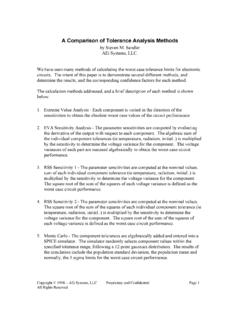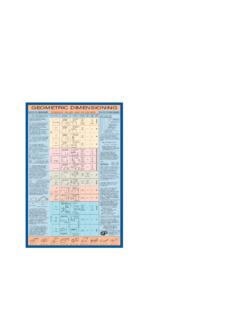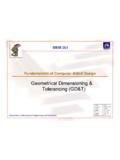Transcription of Tolerancing - ceet.niu.edu
1 Tolerancing MEE270, KIM, NIU 1 tolerance is the total amount a specific dimension can vary. tolerance are assigned so that any 2 mating parts will fit together, as shown in (a). In this case, the actual hole may not be less than inch and not more than inch; these are the limits for dimension, and the difference between is the tolerance . A metric version is shown in (b). 11-1 Introduction MEE270, KIM, NIU 2 In Fig. (a), the max. shaft is shown solid and the min. shaft is shown phantom. The difference is .001 . This difference .001 is the tolerance for the shaft.
2 Similarly, the tolerance for the hole is .001 . The loosest fit, or maximum clearance, occurs when the smallest shaft is in the largest hole, as shown in (b). The tightest fit is shown in (c). The difference between the largest allowable shaft size and the smallest allowable hole size is called allowance. Allowance MEE270, KIM, NIU 3 When parts are required to fit properly in assembly but not to be interchangeable, parts are not always toleranced but sometimes just indicated to be made to fit at assemble, as example below. MEE270, KIM, NIU 4 Normal size is used for general identification and is usually expressed in decimals or common fractions.
3 In figure (a), the normal size of both hole and shaft would be . Basic size, or basic dimension, is the theoretically exact size from which limits of size are determined by applying allowance and tolerance . It is the size from which limits are determined for the size, shape, or location of a feature. For above example, the basic size is the same as the normal size, 1,25 inch. 11-2 Size Designations MEE270, KIM, NIU 5 Actual size is the measured size of the finished part. Allowance is the minimum clearance space (or maximum interference) between mating parts.
4 Allowance represents the tightest possible fit. For clearance fits this difference will be positive, but for interference fits it will be negative. MEE270, KIM, NIU 6 Clearance Fit, where an internal member fits into an external member (as a shaft in a hole), always has space or clearance between the parts. See example below. 11-3 Fits Between Mating Parts MEE270, KIM, NIU 7 Interference fit, where the internal number is always larger than the external number, requires that the parts be forced together. In Fig. (a), the smallest shaft is and the largest hole is , so the interference of metal between parts amounts to at least.
5 00070 . An inference fit always has a negative allowance. Transition fit results in either a clearance or interference condition. In Fig. (b), the smallest shaft, , will fit into the largest hole, . But the largest shaft, , will have to be forced into the smallest hole, . MEE270, KIM, NIU 8 If allowances and tolerances are specified properly, mating parts are completely interchangeable. But for close fits, it is necessary to specify very small allowances and tolerances, and the cost will be very high. To avoid this expense, either manual or computer-controlled selective assembly is often used.
6 In selective assembly, all parts are inspected and classified into several grades according to actual sizes. 11-4 Selective Assembly MEE270, KIM, NIU 9 Reamers, broaches, and other standard tools are often used to produce holes, and standard plug gages are used to check the actual size. Shafts are easily machined down to any size desired. Therefore, toleranced dimensions are commonly determined using the basic hole system, in which the minimum holes is taken as the basic size. Then the allowance is determined, and the tolerance are applied. 11-5 Basic Hole System MEE270, KIM, NIU 10 A reamer is a rotary cutting tool used to enlarge the size of a previously formed hole by a small amount but with a high degree of accuracy to leave smooth sides.
7 The following shows some of reamer tools. MEE270, KIM, NIU 11 Broaching is a machining process that uses a toothed tool, called a broach, to remove material when precision machining is required, especially for odd shapes, like keyholes. MEE270, KIM, NIU 12 Lapping is a machining process, in which two surfaces are rubbed together with an abrasive between them, by hand movement or by way of a machine. MEE270, KIM, NIU 13 Honing is an abrasive machining process that produces a precision surface on a metal workpiece by scrubbing an abrasive stone against it MEE270, KIM, NIU 14 In some industries, they use the basic shaft systems.
8 It is advantageous when several parts having different fits, are required on a single shaft, or when the shaft for some reason cannot be machine to size easily. In this system, the maximum shaft is taken as the basic size, an allowance for each mating part is assigned, and the tolerance are applied. 11-6 Basic Shaft System MEE270, KIM, NIU 15 A tolerance of a decimal dimension must be given in decimal form, as shown in Fig. General tolerance on decimal dimensions in which tolerances are not given may be covered in a print note such as DECIMAL DIMESION TO BE HELD TO.
9 001. 11-7 Specification of Tolerances MEE270, KIM, NIU 16 There are several methods of expressing tolerances in dimensions that are approved by ANSI and they are as follows. 1. Limit dimensioning. In this preferred method, the maximum and minimum limits are specified, as shown below. The maximum value is placed above the minimum value as shown in Fig. (a). In the single-line note form, the low limit precedes the high limit separated by a dash, as shown in Fig. (b). MEE270, KIM, NIU 17 2. Plus-or-Minus dimensioning. In this method the basic size is followed by a plus-or-minus expression for the tolerance .
10 The result can be either unilateral, where the tolerance only applies in one direction so that one value is zero, or bilateral, where either the same or different values are added and subtracted as show below. If the plus and minus values are the same, a single value is given, preceded by the plus-or-minus symbol, as shown below. MEE270, KIM, NIU 18 If the plus and minus values are the same, a single value is given, preceded by the plus-or-minus symbol, as shown below. MEE270, KIM, NIU 19 3. Single-limit dimensioning. It is not necessary to specify both limits.










